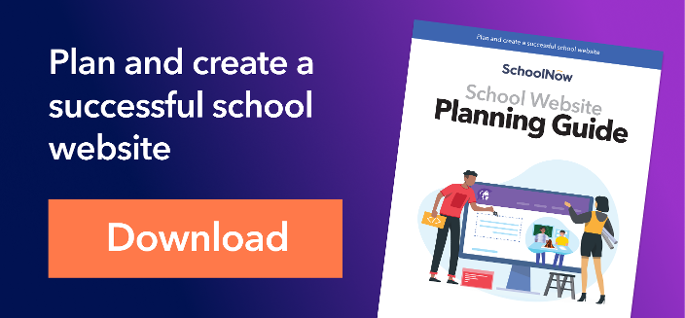We’re getting a recurring question these days from readers of our blog, customers and webinar attendees: should I get a website that features responsive design or do I really need to get a mobile app?
It is safe to say things are changing fast in technology, and as a school professional, you need to adapt with the times. With the rapid and continued increase in the number of mobile users, schools are having to rethink how they communicate and make sure they are connecting to families and the community how they like to communicate. Today, that is safe to say it is mobile.
So back to the question: Does my school need a mobile app, a responsive website or both? The answer, which I promise I will get to, is based on many factors.
First things first. We all know what an app is. We're in an app-happy world these days. If your phone is anything like mine, it’s chock full of apps for everything from ordering pizza, tracking my favorite teams, or playing Scrabble online with strangers from faraway places. These software applications designed specifically for tablets and smartphones literally go hand-in-hand with the growth of mobile devices. Got your Apple watch yet?
Responsive design is a little fuzzier to grasp, but every bit as important – if not more so – than mobile apps. Responsive design is a web design format that optimizes the website experience regardless of the device on which you’re viewing the website. It cuts down on all the resizing, pinching, panning, and scrolling, and makes it easy to get to the information you’re seeking, quickly and painlessly. One website works across all platforms and devices – from desktops to smart watches and everything in between.
Hit your moving targets however you can
Mobile marketing expert Greg Hickman's recently reported Social Media Marketing World Conference that 76% of visitors will abandon your website if the page doesn't load on mobile, and 46% are unlikely to return.
Business and commerce were the early adopters of responsive web design and mobile apps, but now there’s a push to provide the same convenience to broader markets, namely, schools.
The responsive design/mobile app conundrum, however, is not an either/or question. To me, it’s a which- first question? Let's start with RD.
Reasons for a website with responsive design:
1. Responsive design ensures your website plays well others
The biggest benefit of responsive design is that it works and plays well with any device you can throw at your website. Desktops, tablets, smartphones, watches and whatever the next wearable or mobile invention might be. There's no compromise of content, no sacrifice that your message is garbled or cut off. In fact, a website with responsive design can make your website look pretty cool on a phone or tablet.
2. Google penalizes you for not having responsive design
In a recent Mashable article, J.P. Mangalindan cites that Google searches on mobile will soon begin giving priority to those websites deemed mobile friendly. This means websites that feature responsive design and have a site map that features solid navigation get preferential treatment in Google’s search algorithms (and other aspects that can help your school.) Google's ever-growing sphere of influence continues to expand. More on that later in this article.
3. Responsive design supports mobile apps
Another great benefit of responsive design is that it plays well with not only all the various devices, but, if configured correctly, also plays well with mobile apps. The reverse cannot be said.
4. Responsive design mixes well with social media
Your school’s social media accounts are easy and seamlessly accessible via mobile devices when your school website features responsive design. The same content that’s posted to your Twitter, Facebook, Instagram, Youtube and other social media channels can be automatically pulled from and linked to your website.
5. Email is more powerful with a website featuring responsive design
In addition to social media, email, already the most popular choice of digital communications for most school districts, can be more effective when your website has responsive design. Considering that 50 percent of people use mobile devices to read email, if you are including links in your emails – which you should be – you are combining two of the most powerful digital tools you have. Without responsive design, an email with a link to a school newsletter, for example, might be missing half of your audience.
Reasons for choosing a school mobile app:
1. Mobile apps are becoming a way of life
Are they fads, or are they part of a powerful trend of having a native mobile app for every facet of our lives. Heck, there are even apps out there to help you organize and manage all your apps. For many, it’s the way to manage their online entertainment, their finances, their love lives. Between app stores on iTunes, Google and Amazon, there’s close to a 1.5 million apps available, so your school should probably get in the mix too.
2. Mobile apps 'push' notifications for immediate delivery
A really nice feature many mobile apps provide is the ability to send push notifications to your school community. Great for important announcements, emergency or breaking news, “pushed” notices appear right away on the user’ screen – even without the app open – providing they’ve been set it up correctly. Some providers offer a variety of solutions from stand-alone emergency notification service to custom mobile apps.
3. Mobile apps take advantage of native smartphone features
Because smartphones have all sorts of features, some mobile apps work easily with all the additional bells and whistles the latest and greatest devices might have. Cameras, calendars, geolocation, media, contacts can all integrate with a well-designed mobile app.
4. Other school data systems integrate on mobile apps
Some mobile apps work well with other data systems at work in school such as your Student Information System (SIS). School administrators can even use their own mobile devices to manage the content on a mobile app. As with any other mobile app however, users must stay on top of the software updates that come with the mobile app territory.
More on Google and your school website
Anything you can do these days to stay friendly with mobile devices and Google would bode well for your website, even if it’s not a commerce-intensive or particularly search- intensive application such as school site.
Google search is a valuable tool for schools, I might add, for it’s easy to embed your site with an app that automatically crawls your site, indexes your pages and content so that it shows up in your own website’s search field. It’s like having your own, Google-powered search engine for your site. In fact, that’s exactly what it is.
Google custom search, translator, and other Google services are additional good reasons to consider Google Apps for Education and keep your school’s website “Google friendly.” (Mangalindan says that 89% of all smartphone owners worldwide conduct searches on Google.)
Conclusion
While the pressure is definitely on business and commercial sites to shift to responsive design, schools and colleges also face the prospect of lost communications opportunities without a mobile strategy. Both responsive design and mobile apps should be part of your strategy.
As we promote our newest version of our content management system that features responsive design, the easy answer would be, sure, go with a CMS that features responsive design and you’ll be set for now and the future.
If you have a site that automatically responds to mobile devices, you don't really need a mobile app. However – and this is a huge however – more and more people prefer mobile apps as their modus operandi, so it makes sense to provide those too if that’s what they want.
Ideally, schools should offer up their website both ways to accommodate user preferences. Start with a solid website with CMS, add a mobile app that pulls content from the website, and you’ll be set. For now, at least.
Topics: School Districts Private schools Website design Content management Mobile app
About the author
Marketing director and content strategist for SchoolNow, Jay’s a former school public relations specialist who’s helped businesses, schools and colleges use the power of communications to improve their image, generate support, and optimize relationships. Reach him at jay@schoolnow.com.
.png?width=64&height=63&name=Group%20(4).png)
.png?width=66&height=64&name=Group%20(5).png)
.png?width=56&height=60&name=Group%20(6).png)
.png?width=66&height=52&name=Group%20(7).png)
.png?width=56&height=56&name=Group%20(9).png)
.png?width=59&height=52&name=Group%20(10).png)


